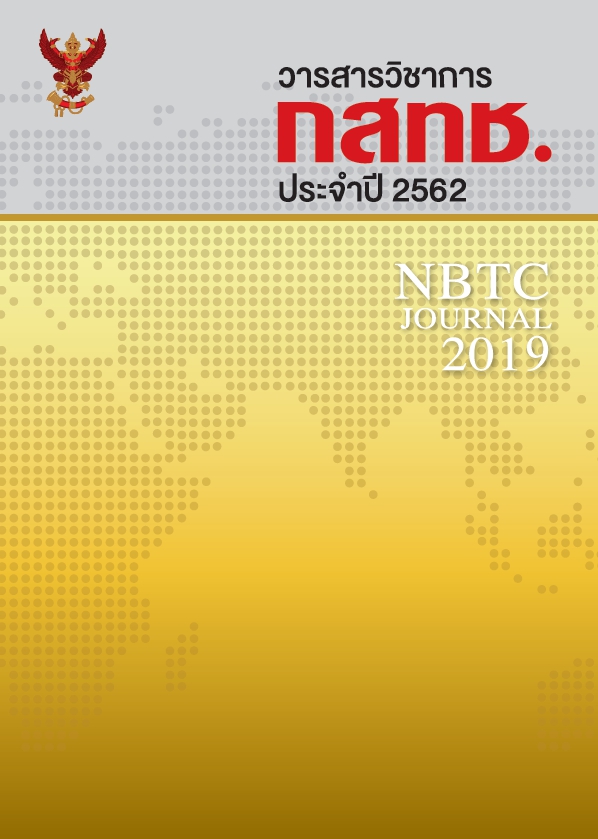Performan Study of Television with Spaces (TVWS) Pilot Network in Thailand
Keywords:
Delay, SNR, Speed, Spectrum Occupancy, JitterAbstract
In this paper, we study the performances of a Television White Space (TVWS) pilot network, which is deployed in a rural and remote region in Northern Thailand. TVWS referring to vacant channels in the Ultra-High Frequency (UHF) band between 510 MHz and 790 MHz assigned for Digital Television (DTV) broadcast and can be used opportunistically by Secondary Users (SUs). The TVWS pilot network provides a point-to-multi-point Internet connectivity to three rural locations. We investigate the basic network performance metrics including the powers of received signals, network throughputs, round-trip latencies, packet losses, and jitters. The performance results show good throughput for each link, which is in the magnitude of 4 to 13 Mbps. The latency and jitter in both point-to-point and point-to-multi-point modes are less than 16 ms for typical packet sizes ranging from 32 to 1500 bytes and less than 2.5 ms, respectively. In addition, the packet loss rate, which is proportional to bit rate, is less than 10% at the data rate of 5 Mbps indicating good performance of the network. The performance is excellent and suitable for voice, video and real-time data transmissions. A TVWS based wireless broadband system can be considered as a good alternative with low cost for both hard-to-access rural areas or for data offloading techniques in dense cellular networks in major cities such as Bangkok and for supporting emerging applications such as Internet of Things (IoT).
References
Lysko, A. A., Masonta, M. T., & Johnson, D. L. (2015). Measuring the Television White Space Opportunity in
Southern Africa Using Field Measurements. Springer, White Space Communications, D. L. Johnson & A. K.
Mishra (Eds), 75-116.
Masonta, M. T., Kliks, A., & Mzyece. M. (2013). Framework for TV white space spectrum access in Southern
African Development Community (SADC). In 24th IEEE Int. Symposium on Personal, Indoor and Mobile Radio
Communications, London, UK.
Masonta, M. T., Ramoroka, T. M., & Lysko, A. A. (2015). Using TV white spaces and e- learning in south african rural
schools. In IST Africa Conference, Lilongwe, Malawi.
Microsoft. (2013). Crossing the chasm and onto the main street: TV white spaces technology spreads its wings
across Singapore with new commercial pilots. United Kingdom, Office of Communications Statement. Retrieved
from https://news.microsoft.com/ensg/2013/06/16/crossingthechasmando/.
Mikeka, C., Thodi, M., Mlatho, J. S., Pinifolo, J., Kondwani, D., Momba, L., Zennaro, M., & Moret, (2014). A.
Malawi television white spaces (TVWS) pilot network performance analysis. Journal of Wireless Networking
and Communications, 4(1), 26-32
NICT. (2014). Trials of TV white space communications at 40 Mbps in Central London. National Institute of
Information and Communications Technology. Retrieved from https://www.nict.go.jp/en/press/2014/07/24-1.html.
Ofcom. Implementing TV white spaces. (2015). United Kingdom, Office of Communication Statement. Retrieved
from https://stakeholders.ofcom.org.uk/binaries/consultations/white-space-coexistence/statement/tvws-
statement.pdf.
Radio Mobile. (2014). Retrieved from https://radiomobile.pe1mew.nl/.
Westcott, C. and David, D. (2012). Certified Wireless Network Administrator Official Study Guide. 111 River St.
Hoboken, NJ 07030: John Wiley & Sons, Inc. p. 126. ISBN 978-1-118-26295-5.
Downloads
Published
How to Cite
Issue
Section
License
The Office of the NBTC holds the copyright of articles appearing in the journal. The Office of the NBTC allows the public or individuals to distribute, copy, or republish the work under a Creative Commons license (CC), with attribution (BY), No Derivatives (ND) and NonCommercial (NC); unless written permission is received from the Office of the NBTC.
Text, tables, and figures that appear in articles accepted for publication in this journal are personal opinion and responsibility of the author, and not binding on the NBTC and the Office of the NBTC. In case of errors, each author is solely responsible for their own article, and not concerning the NBTC and the NBTC Office in any way.



